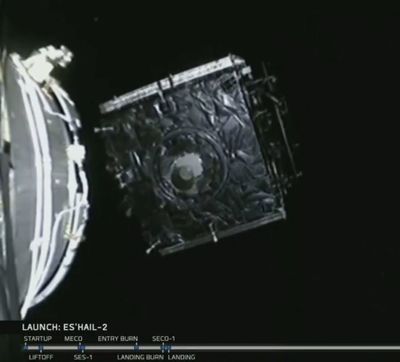Difference between revisions of "Es'hail-2 Basic Information"
| (54 intermediate revisions by 5 users not shown) | |||
| Line 1: | Line 1: | ||
| − | + | Oscar 100 is 2 amateur radio transponders hosted on the Es’hail-2 Direct Broadcast TV satellite owned by Es’hailSat in Qatar and is the first ever amateur payload on a commercial geostationary satellite | |
| − | + | [[File:seperation.JPG|400px]] | |
| − | + | The satellite was built by Mitsubishi Electric Company ( MELCO) in Japan and is a collaborative project with Es’hailSat / AMSAT-DL / Qatar ARS | |
| − | + | For more details see this presentation given by G8GTZ and G8GKQ at the RSGB AGM 2019. | |
| − | + | [[:File:RSGB AGM V2.pdf]] | |
| − | |||
| − | == | + | ==Aligning your dish== |
| − | The | + | The original step by step guide to setting up and aligning your dish to receive Es'hail-2 appeared in CQ-TV 261 contains good advice on setting up your dish and the direction of satellite and is available for download here: [[:Media:Getting ready for Es'hail2.pdf|Getting ready for Es'hail-2]] |
| − | === | + | However, now Oscar 100 is "on air" the advice about aligning your dish on BADR4 etc can be used alongside aligning the dish on the narrow band transponder. |
| + | |||
| + | More details on LNBs, including modifying the Octagon units for external lock can be found here: [[Es'hail-2_LNBs_and_Antennaes]] | ||
| + | |||
| + | ====Narrow band transponder==== | ||
| + | |||
| + | Use some SDR hardware (and a £10 RTL dongle will do) and something like the SDRconsole or SDR# programs set for 1 MHz bandwidth centered on 739 / 740MHz. Supply 12v to the LNB and look for a bump of around 500 kHz bandwidth. | ||
| + | |||
| + | This is the easiest way as there are no other signals in that band, set the elevation to ~ 26 degrees and gently scan across in Azimuth until you see the bump. | ||
| + | |||
| + | ====Aligning for DATV==== | ||
| + | |||
| + | The easiest way to align your dish for TVis to follow the guide below - note the BADR4 transponder containg BBC Arabic is Horizontal and requires 18v to the LNB - same as the Oscar 100 WB transponder - can be received on a MiniTiouner by tuning to 2246MHz with a 27500 SR. | ||
| + | |||
| + | You can then use the TV beacon to tweak for maximum signal - the types of MER you should receive depending on dish size are listed on the bottom of this page: https://wiki.batc.org.uk/Receiving_Oscar_100_DATV_signals | ||
| + | |||
| + | ==Receiving Oscar 100 DATV signals== | ||
| + | |||
| + | A guide to receiving the DATV signals in the wideband transponder can be found here [[Receiving Oscar 100 DATV signals]] | ||
| + | |||
| + | ==Transmitting DATV on Oscar 100== | ||
| + | |||
| + | A guide to transmitting DATV in the wideband transponder can be found here [[Transmitting Oscar 100 DATV signals]] | ||
| + | |||
| + | ==List of Current Active Users== | ||
| + | |||
| + | [[QO100 DATV Users]] | ||
Latest revision as of 08:16, 10 September 2025
Oscar 100 is 2 amateur radio transponders hosted on the Es’hail-2 Direct Broadcast TV satellite owned by Es’hailSat in Qatar and is the first ever amateur payload on a commercial geostationary satellite
The satellite was built by Mitsubishi Electric Company ( MELCO) in Japan and is a collaborative project with Es’hailSat / AMSAT-DL / Qatar ARS
For more details see this presentation given by G8GTZ and G8GKQ at the RSGB AGM 2019.
Aligning your dish
The original step by step guide to setting up and aligning your dish to receive Es'hail-2 appeared in CQ-TV 261 contains good advice on setting up your dish and the direction of satellite and is available for download here: Getting ready for Es'hail-2
However, now Oscar 100 is "on air" the advice about aligning your dish on BADR4 etc can be used alongside aligning the dish on the narrow band transponder.
More details on LNBs, including modifying the Octagon units for external lock can be found here: Es'hail-2_LNBs_and_Antennaes
Narrow band transponder
Use some SDR hardware (and a £10 RTL dongle will do) and something like the SDRconsole or SDR# programs set for 1 MHz bandwidth centered on 739 / 740MHz. Supply 12v to the LNB and look for a bump of around 500 kHz bandwidth.
This is the easiest way as there are no other signals in that band, set the elevation to ~ 26 degrees and gently scan across in Azimuth until you see the bump.
Aligning for DATV
The easiest way to align your dish for TVis to follow the guide below - note the BADR4 transponder containg BBC Arabic is Horizontal and requires 18v to the LNB - same as the Oscar 100 WB transponder - can be received on a MiniTiouner by tuning to 2246MHz with a 27500 SR.
You can then use the TV beacon to tweak for maximum signal - the types of MER you should receive depending on dish size are listed on the bottom of this page: https://wiki.batc.org.uk/Receiving_Oscar_100_DATV_signals
Receiving Oscar 100 DATV signals
A guide to receiving the DATV signals in the wideband transponder can be found here Receiving Oscar 100 DATV signals
Transmitting DATV on Oscar 100
A guide to transmitting DATV in the wideband transponder can be found here Transmitting Oscar 100 DATV signals
